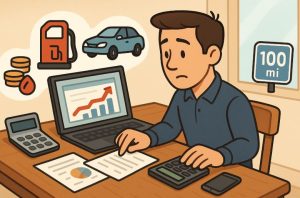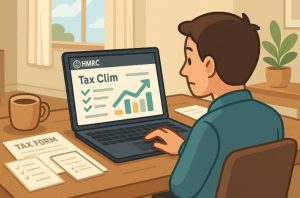Navigating the world of employee tax relief can seem daunting, but understanding what you can claim back could save you a considerable amount of money each year.
In 2025, many UK employees are eligible to claim back a range of expenses, provided they meet HMRC’s specific criteria. This professional guide outlines everything you need to know about claiming back tax as an employee.
Who Is Eligible to Claim Tax Relief as an Employee?

Understanding who qualifies for tax relief is essential before making a claim. HMRC has clear rules designed to ensure that only genuine, work-related expenses are refunded. Eligibility depends on factors such as the nature of the expense, the employment terms, and how the costs were handled by the employer.
General Conditions for Eligibility
Employees must have incurred expenses that are necessary for performing their employment duties. These expenses must be paid for out of the employee’s own pocket and should not have been reimbursed in full by the employer.
It is not sufficient for an expense to simply assist with work; it must be essential for carrying out the role.
Furthermore, the employee must have paid income tax in the tax year they are claiming. The relief cannot exceed the amount of tax paid. In addition, expenses must have been incurred wholly, exclusively, and necessarily for the job. This means the cost must relate only to the performance of duties, with no significant private benefit.
For instance, if an employee purchases safety boots required on construction sites, this would qualify. However, buying a general pair of shoes, even if worn for work, would not meet HMRC’s criteria unless the shoes are specialised and necessary.
When Tax Relief Cannot Be Claimed?
There are circumstances where tax relief is not available, even if expenses are related to work. If an employer reimburses the full cost of an item or service, the employee cannot make a separate claim for tax relief.
Equally, if an employer provides an alternative, such as issuing work equipment directly, no claim can be made for preferring a different model or brand.
Claims are also rejected if the expenses have a mixed-purpose use. If the cost benefits the employee personally as well as professionally, and it is not possible to clearly separate the business use, tax relief cannot be claimed. For example, home broadband costs usually cannot be claimed if used for both personal and professional purposes.
Employees who voluntarily choose to work from home, where there is an option to work in the office, are not eligible to claim tax relief for homeworking expenses. HMRC’s rules make it clear that only employees who are required to work from home are entitled to such claims.
Importance of Paying Income Tax
A key requirement often overlooked is that you must have paid income tax during the tax year for which you are making a claim. If you earned below the personal allowance threshold and paid no tax, you cannot receive a refund.
The maximum relief granted cannot exceed the amount of tax actually paid, ensuring that relief remains proportional to an individual’s tax contributions.
Documentation and Evidence Requirements
Eligibility is not determined by claims alone; HMRC requires robust evidence to support any application. Employees should retain:
- Receipts for purchases and services
- Employment contracts or employer letters that mandate specific working conditions
- Detailed mileage logs, where applicable
- Utility bills showing additional homeworking costs
Maintaining thorough records is critical, not only to support a claim but also to ensure compliance in the event of a later audit or query from HMRC. Claims without sufficient evidence risk being denied, and false claims could result in penalties.
How Does Tax Relief Work for Employees?

Understanding how tax relief operates helps employees make informed claims. When you incur a work-related cost, the tax relief you can claim is calculated based on the amount spent and your personal income tax rate.
For instance:
- If you spend £150 and you pay tax at 20%, you could receive £30 as tax relief (20% of £150).
- Higher-rate taxpayers (40%) would receive £60 for the same expense.
Employees making claims for the current tax year usually see an adjustment to their tax code. This results in paying less tax each month.
For claims relating to previous years, HMRC might either adjust the tax code or issue a lump-sum refund.
Here is a simplified view:
| Expense Incurred | Tax Rate | Tax Relief Received |
| £60 | 20% | £12 |
| £60 | 40% | £24 |
Employees should ensure that all claims are accurate and supported by proper documentation to prevent delays or rejections.
What Expenses Can You Claim If You Work From Home?
Employees who are required to work from home may claim tax relief for the additional household expenses incurred. Working from home must be a necessity of the role, not a personal choice, to qualify.
Eligible claims typically cover:
- Additional gas and electricity costs
- Business-related telephone calls
Expenses like rent, council tax, and broadband cannot be claimed if they serve both private and professional purposes.
Claiming Methods
- A flat rate of £6 per week without the need for receipts.
- The exact amount incurred, supported by bills and receipts.
When opting to claim the actual amounts, employees must submit detailed evidence such as energy bills showing increased usage attributed to homeworking.
If claiming the flat rate, evidence of the requirement to work from home may still be requested.
Tax relief is available for both the current tax year and the four previous tax years.
Can You Claim for Uniforms, Work Clothing, and Tools?
Tax relief on uniforms, work clothing, and tools is a common claim among employees in many sectors.
To qualify, the items must be necessary for your job and must either identify your occupation (in the case of uniforms) or be essential for safety and function (in the case of specialist clothing and tools).
Eligible Claims Include
- Repairing or replacing small tools such as hammers, scissors, or electric drills.
- Cleaning, repairing, or replacing uniforms or protective clothing like overalls or safety boots.
Employees cannot claim for:
- The initial purchase of everyday clothing, even if it is colour-specific or style-specific for the workplace.
- Laundry costs if a free laundering service is offered by the employer but not used.
Flat Rate Expenses: Many occupations have pre-agreed flat rates for uniform maintenance, meaning employees can claim without submitting receipts. For example:
| Occupation | Flat Rate Expense (Annual) |
| Nurses | £125 |
| Mechanics | £120 |
| Pilots | £1,022 |
If your role is not listed under HMRC’s flat rate expenses, you must submit proof of your actual costs.
What Vehicle Expenses Are Allowable for Tax Claims?

Employees using their own vehicles for work purposes can claim mileage allowance relief. This covers business travel but not commuting between home and a permanent place of work.
Approved Mileage Rates for 2025
| Vehicle Type | First 10,000 Miles | Over 10,000 Miles |
| Car/Van | 45p per mile | 25p per mile |
| Motorcycle | 24p per mile | 24p per mile |
| Bicycle | 20p per mile | 20p per mile |
It is crucial to keep accurate mileage logs that record:
- Date and purpose of each journey
- Start and end addresses
For those using a company vehicle, only the cost of fuel for business journeys is claimable. Employees must deduct any reimbursements already received from the employer before calculating their claim.
Are Professional Fees and Subscriptions Tax-Deductible?
Employees required to pay professional fees or subscriptions to perform their job can claim tax relief, provided the professional body is approved by HMRC. These fees are often mandatory in industries like law, medicine, accountancy, and education.
You can claim if:
- Membership is essential to perform your job duties.
- The organisation appears on HMRC’s list of approved bodies.
You cannot claim if:
- The subscription was paid for by the employer.
- The fee is for life membership.
Professional bodies and societies often provide statements indicating whether fees are eligible for tax relief. Employees should retain receipts or direct debit records for the fees paid.
Can You Claim Travel and Overnight Expenses for Work?
Business travel costs are another area where tax relief may be available. This excludes everyday commuting, but includes travel to temporary workplaces or trips essential for work purposes.
Claimable expenses include:
- Train, bus, or taxi fares
- Hotel accommodation costs
- Meals purchased during overnight stays
- Congestion charges and tolls
- Business-related parking fees
- Business phone call expenses
Employees must keep receipts showing the date, vendor, and amount spent. Claims can also include incidental expenses up to a certain amount for overnight stays, such as small tips or charges for hotel services related to the business trip.
How Can You Submit Your Tax Claim to HMRC?

Submitting a tax claim to HMRC involves choosing the correct method based on your employment circumstances and the type of expenses you are claiming. In 2025, HMRC continues to offer several channels to make the process straightforward, whether you are claiming for the current tax year or previous ones.
Online Submission via HMRC Services
For most employees with relatively simple claims, the easiest method is to use HMRC’s online service. This platform allows you to:
- Check your eligibility for tax relief
- Submit claims for common expenses like working from home costs, uniforms, tools, professional fees, and business mileage
- Track the status of your claim once submitted
To submit online, you must have a Government Gateway account. If you do not already have one, you can create it during the claim process. Once logged in, the system guides you through step-by-step questions to ensure you submit the correct information.
Submitting a Claim by Post
If your claim is more complex, involves multiple types of expenses, or if you prefer not to use the online service, you can complete a postal form known as P87 for employment-related expenses. This form requires you to manually enter:
- Employment details
- Specific expense categories
- Amounts spent and any reimbursements received
- Supporting explanations where needed
The completed form must be sent to the appropriate HMRC postal address, which can vary depending on your location. It is advisable to send important documents via recorded delivery to ensure safe receipt.
Claiming Through Self-Assessment
If you already complete a Self-Assessment tax return, you must claim your employment expenses as part of your annual return. Expenses are entered in the dedicated section for employment-related costs. This method is mandatory for individuals who:
- Have other income sources (e.g., freelance work, investments)
- Earn above £100,000 per year
- Are otherwise required to submit Self-Assessment returns
When using this method, you should keep detailed supporting documentation, as HMRC may request evidence to verify your claims during audits or reviews.
Evidence and Documentation Required
Regardless of the method you choose to submit your claim, HMRC expects you to retain records for up to six years. This is crucial if your claim is selected for review or investigation. You should keep:
- Receipts for work-related purchases
- Utility bills (for homeworking claims)
- Mileage logs detailing business journeys
- Membership or subscription invoices
- Letters from employers confirming working arrangements (for homeworking claims)
For flat rate expenses, such as uniform allowances, evidence may not be necessary initially, but HMRC reserves the right to request proof of eligibility at any time.
Adjustments and Refunds
If you submit a claim for the current tax year, HMRC usually updates your tax code. This adjustment reduces the amount of tax deducted from your salary throughout the year, meaning you benefit from the relief gradually.
For claims relating to previous tax years, HMRC typically processes a lump-sum refund, which is paid directly into your bank account or via cheque. Claims can take several weeks to process, depending on complexity and workload at HMRC.
Conclusion
Understanding what you can claim back on tax as an employee in 2025 is vital to ensure you are not missing out on entitled financial benefits.
Whether you work from home, travel for your job, or purchase necessary tools and subscriptions, keeping detailed records and following HMRC’s guidelines can maximise your eligible tax relief.
Always review your circumstances yearly and ensure you submit timely and accurate claims to benefit fully.
Frequently Asked Questions
What is the deadline for claiming back tax as an employee?
You have up to four years after the end of the tax year to claim back tax.
Can part-time employees claim tax relief?
Yes, part-time employees can claim tax relief if they meet the eligibility requirements.
How long does it take to get a tax refund from HMRC?
It typically takes HMRC between 5 to 8 weeks to process a tax refund once your claim is submitted.
Do I need my employer’s approval to claim tax relief?
No, you do not need employer approval, but you must not have been fully reimbursed by your employer.
What records should I keep for mileage claims?
Keep detailed logs of business journeys including dates, reasons for travel, and start and end locations.
Is there a minimum amount required to make a tax claim?
There is no strict minimum, but claims of very small amounts may be less practical to pursue individually.
What happens if I make a mistake in my tax relief claim?
You should contact HMRC immediately to correct any errors to avoid potential penalties.








